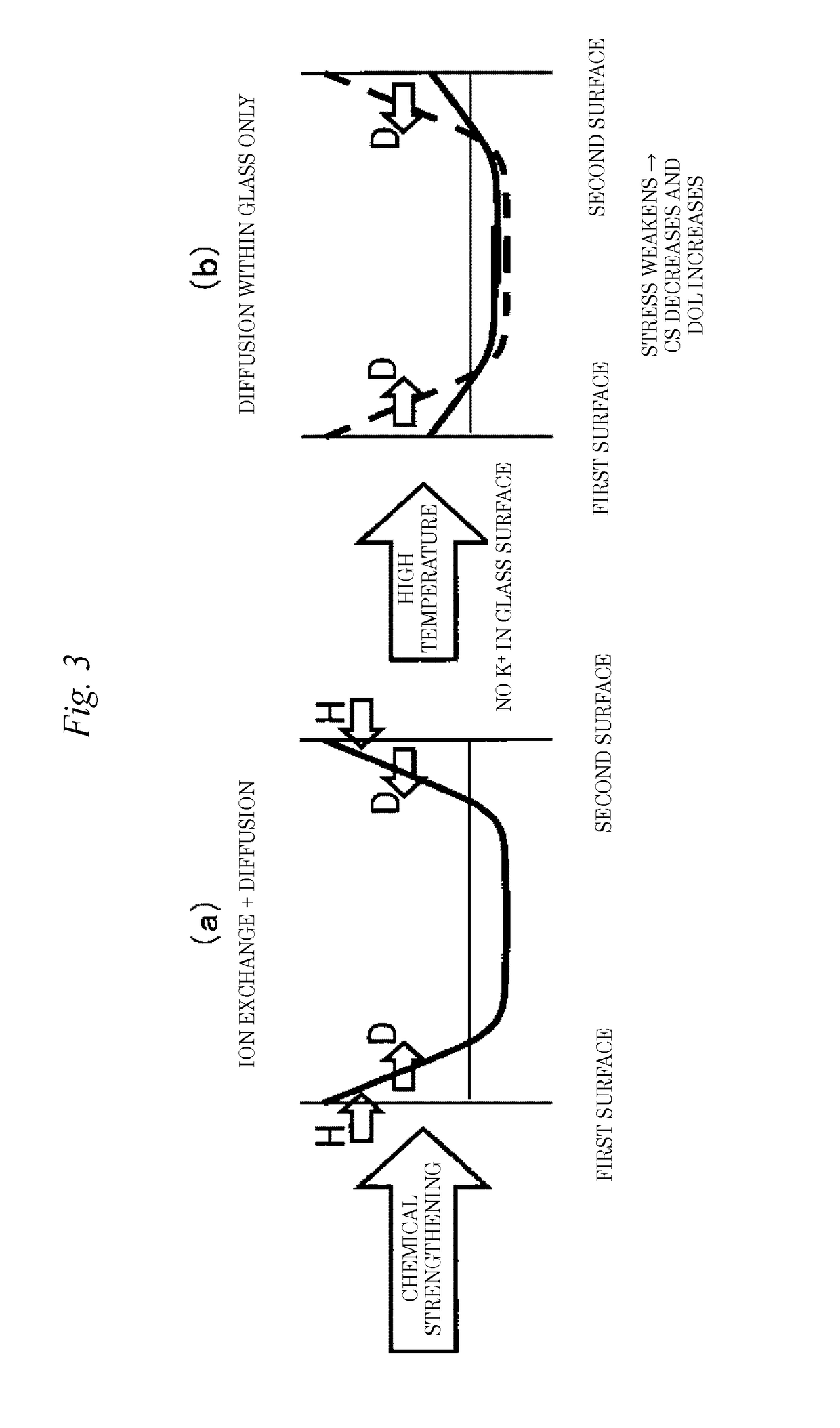Chemically strengthened glass
a technology of chemical strengthening and glass, applied in the field of chemical strengthening glass, can solve the problems of not being able to meet all the requirements at the same time, damage the glass, etc., and achieve the effect of strengthening strength
- Summary
- Abstract
- Description
- Claims
- Application Information
AI Technical Summary
Benefits of technology
Problems solved by technology
Method used
Image
Examples
example 1
[0115]First, a glass having the composition shown below was produced by a float process so that the glass had a thickness of 0.85 mm. This glass plate was cut into a size of 50 mm×50 mm to produce a glass substrate. The glass substrate produced had no warpage.
[0116]Glass composition (in mol %): SiO2 64.4%, Al2O3 8.0%, Na2O 12.5%, K2O 4.0%, MgO 10.5%, CaO 0.1%, SrO 0.1%, BaO 0.1%, ZrO2 0.5%
[0117]Subsequently, pasty inorganic salts having the composition shown below were applied with a coater to one surface (first surface) of the produced glass substrate in a thickness of 1.5 mm.
Composition of pasty inorganic salts (mass ratio): water / K2SO4 / KNO3=6 / 5 / 1
[0118]The glass substrate on which the pasty inorganic salts had been applied to the first surface was transferred to the inside of a heating oven and heat-treated at 500° C. for 15 minutes to thereby perform a chemical strengthening treatment. Thereafter, the glass substrate was cooled to room temperature, washed with pure water to remov...
example 2
[0130]First, a glass having the composition shown below was produced by a float process, and the edge surfaces of the glass were polished with a grindstone #325 to produce a glass substrate having a size of 60 mm×120 mm×0.56 mm (thickness).
[0131]Glass composition (in mol %): SiO2 68.0%, Al2O3 10.0%, Na2O 14.0%, MgO 8.0%
[0132]Subsequently, 2.3 g of a powder having the composition shown below was applied with a coater to one surface (first surface) of the glass substrate in an even thickness.
Composition of powder (mass ratio): KNO3 / K2SO4=1 / 1
[0133]The glass substrate on which the powder had been applied to the first surface was transferred to the inside of a heating oven and burned at 450° C. for 90 minutes to thereby perform a chemical strengthening treatment. Thereafter, the glass substrate was cooled to room temperature, washed with pure water to remove the powder applied to the first surface, and dried.
[0134]Subsequently, a powder having the same composition as that applied to the ...
example 3
[0135]A chemically strengthened glass of Example 3 was obtained in the same manner as in Example 2, except that when producing a glass substrate, the edge surfaces of the glass were polished with a grindstone #600.
PUM
| Property | Measurement | Unit |
|---|---|---|
| Length | aaaaa | aaaaa |
| Radius | aaaaa | aaaaa |
| Length | aaaaa | aaaaa |
Abstract
Description
Claims
Application Information
 Login to View More
Login to View More - R&D
- Intellectual Property
- Life Sciences
- Materials
- Tech Scout
- Unparalleled Data Quality
- Higher Quality Content
- 60% Fewer Hallucinations
Browse by: Latest US Patents, China's latest patents, Technical Efficacy Thesaurus, Application Domain, Technology Topic, Popular Technical Reports.
© 2025 PatSnap. All rights reserved.Legal|Privacy policy|Modern Slavery Act Transparency Statement|Sitemap|About US| Contact US: help@patsnap.com



